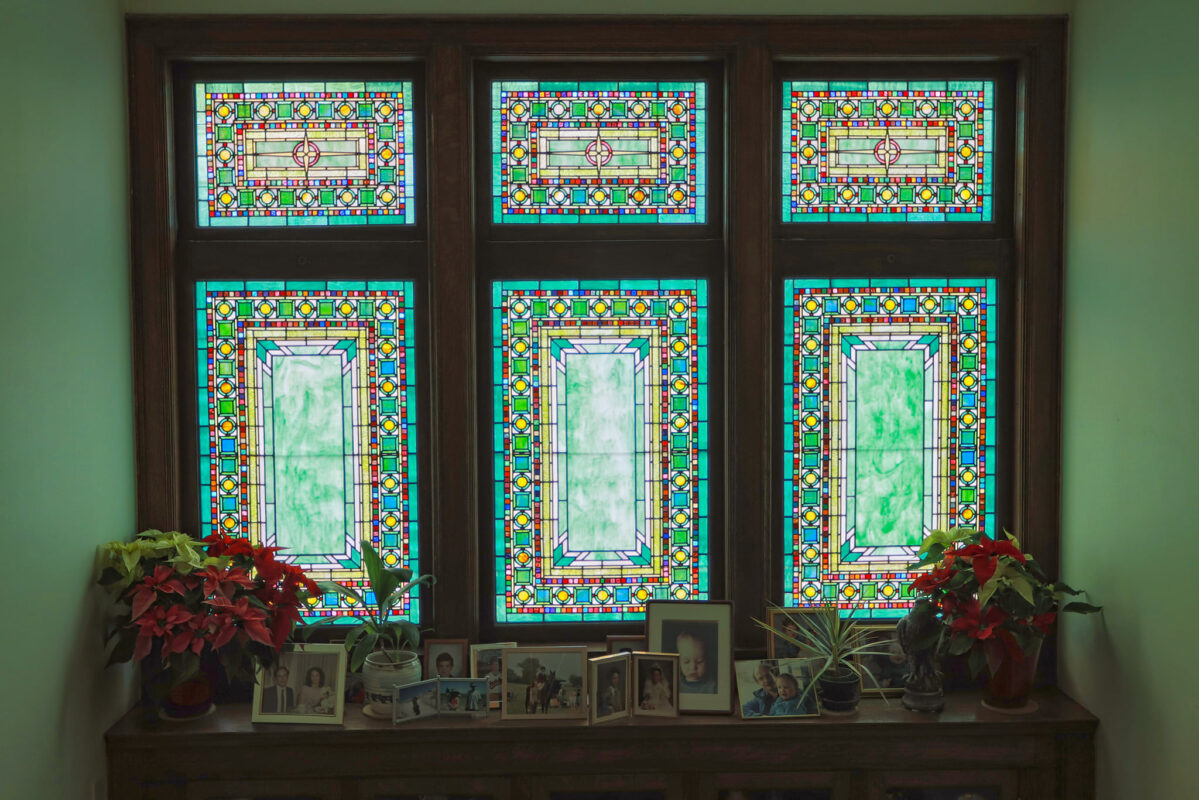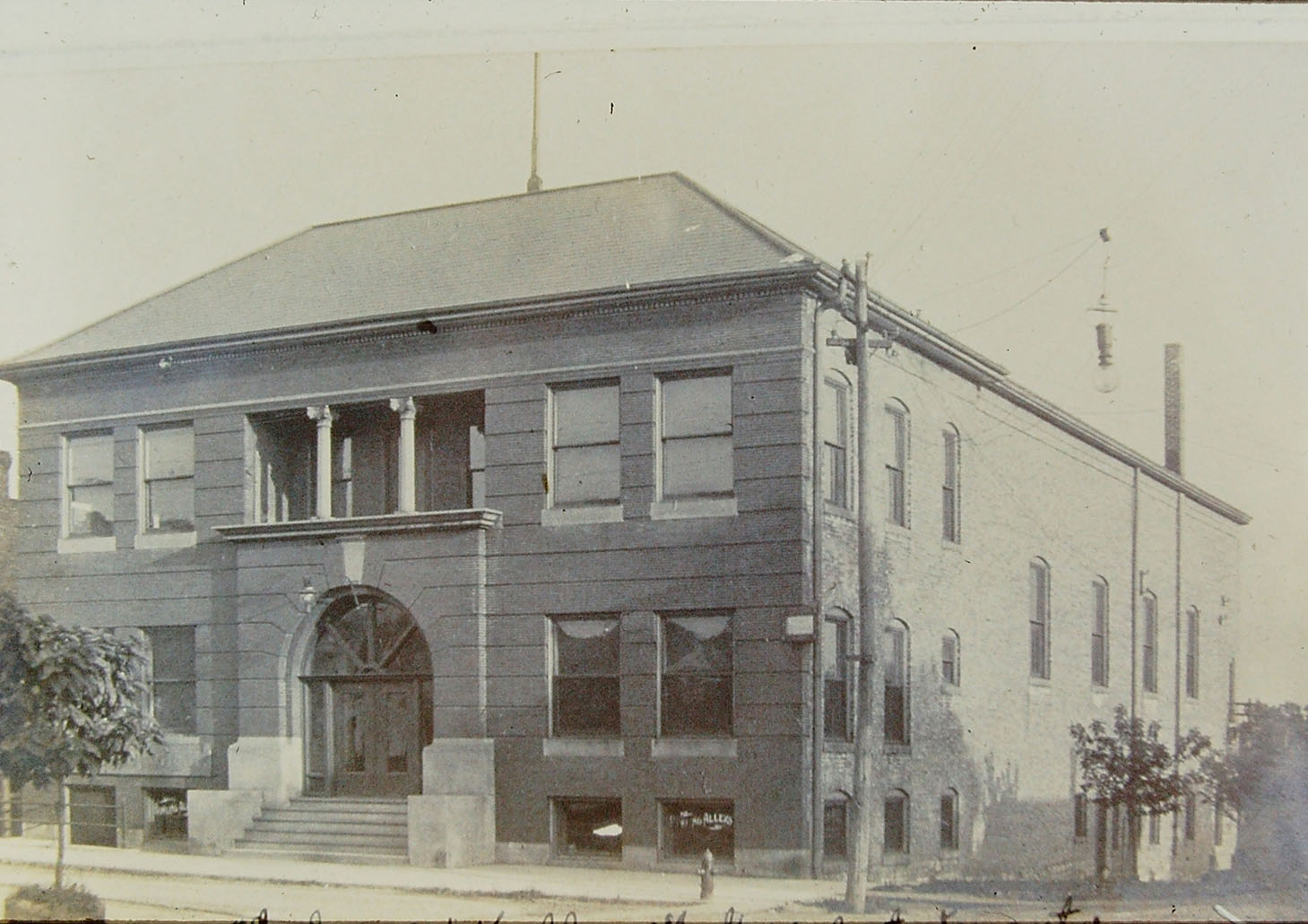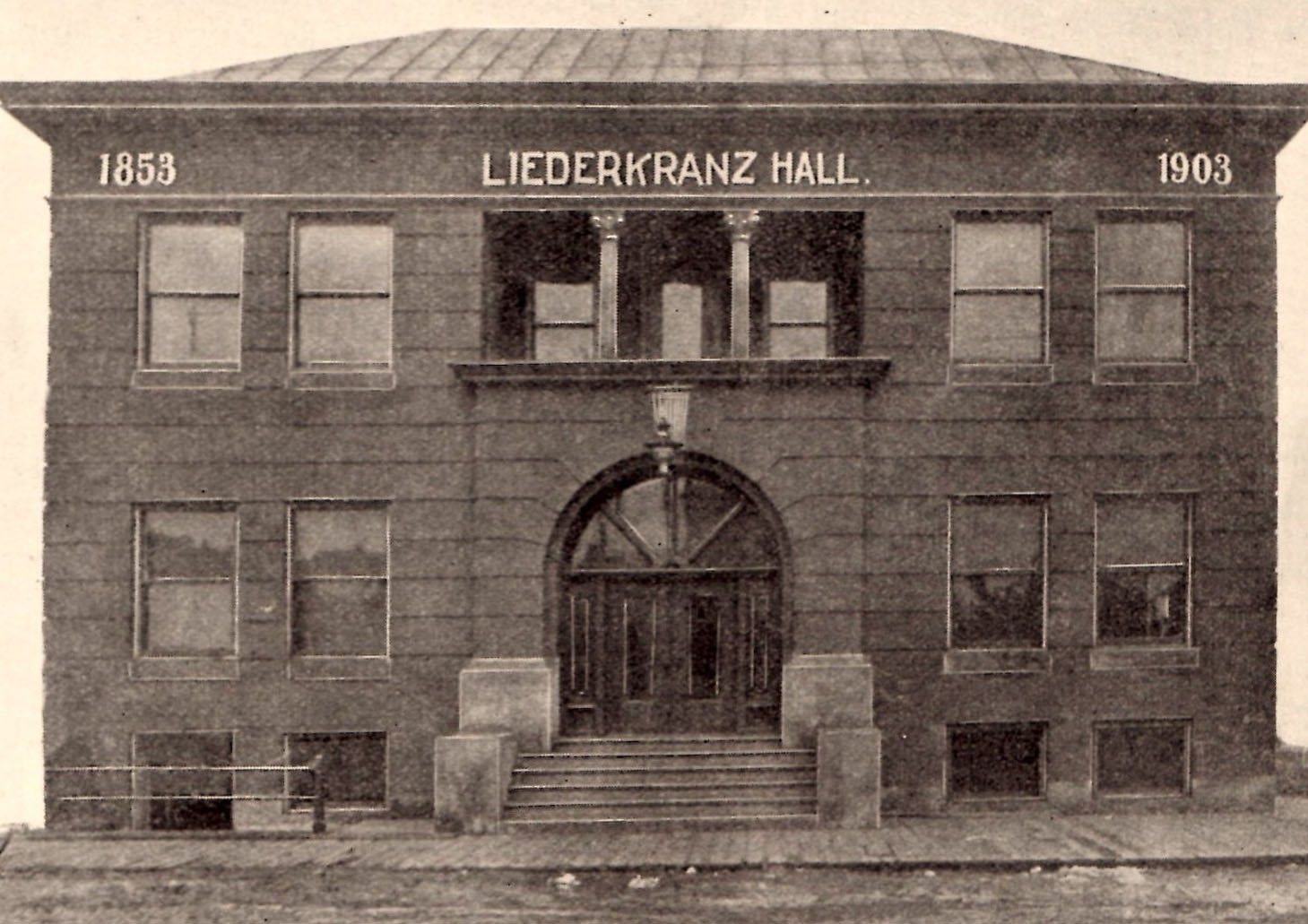Liederkranz Hall
Photos courtesy of the Blue Island Historical Society.
Saenger (Liederkranz) Hall
2427 Grove Street, Blue Island, IL
Built in 1897; destroyed by fire in 1918
Built for Blue Island’s award-winning German music troupe, the Blue Island Liederkranz, this structure replaced the group’s previous wood-frame headquarters – ironically, a structure which also succumbed to a fire. The building was Maher’s first work in Blue Island, leading to the design of two homes, the William Weber and Henry Klein houses, and Sanders School. Likely designed concurrent with his work on Pleasant Home in Oak Park, it marks a turning point in Maher’s career, setting up his Prairie-School-leaning works.
Though a bit more ornate, the design is reminiscent of Sanders School; it’s essentially a large rectangular box, with what appears to be similar brick used for its facade. Both designs feature central, arched entrances, with similar segmented transom windows above double doors. An inset, colonnaded balcony looks like a more ornate take on what the architect would employ for Sanders School, and a design choice that Maher goes on to use in much of his work in the following period.
The article below tells the story of the fire that destroyed the building. We’ve transcribed the text below the snapshots of the article…
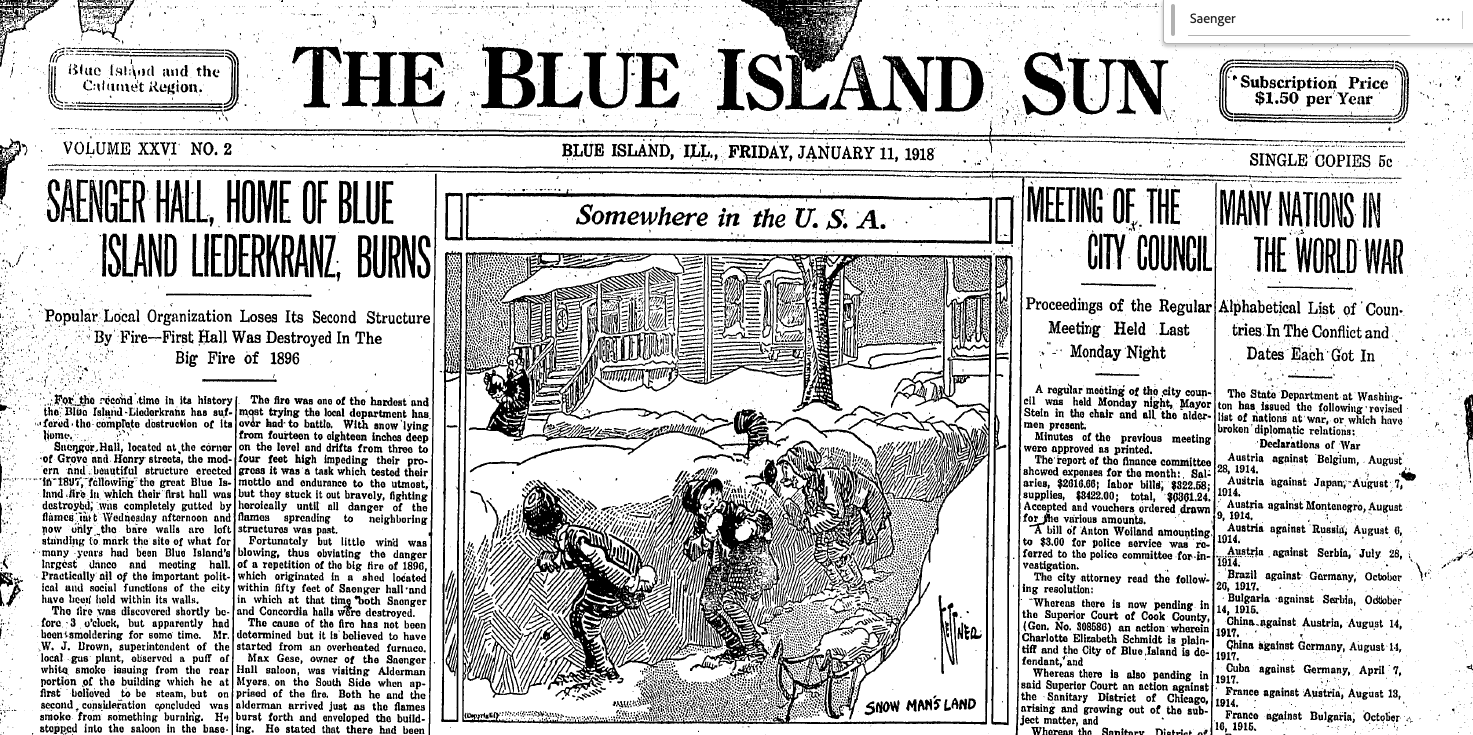
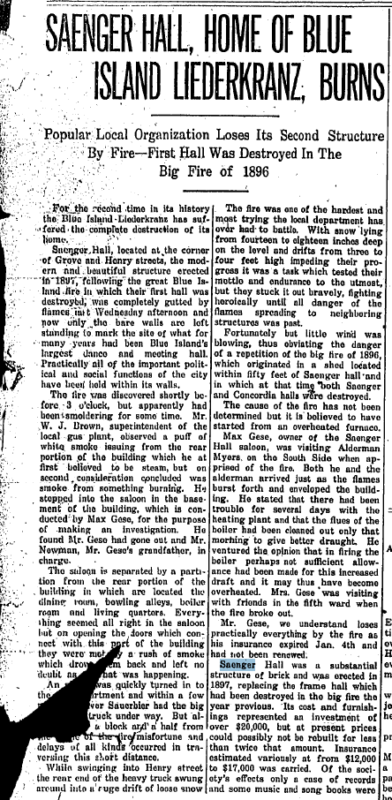
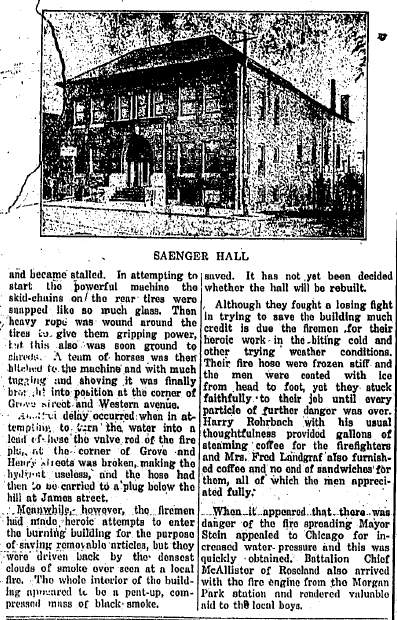
SAENGER HALL, HOME OF BLUE ISLAND LIEDERKRANZ, BURNS
Popular Local Organization Loses Its Second Structure By Fire-First Hall Was Destroyed In The Big Fire of 1896
For the second time in its history the Blue Island Liderkranz has suffered the complete destruction of its home.
Saenger Hall, located at the corner of Grove and Henry streets, the modern and beautiful structure erected in 1897, following the great Blue Island fire in which their first hall was destroyed, was completely gutted by flames last Wednesday afternoon and now only the bare walls are left standing to mark the site of what for many years had been Blue Island’s largest dance and meeting hall. Practically all of the important political and social functions of the city have been held within its walls.
The fire was discovered shortly before 3 o’clock, but apparently had been smoldering for some time. Mr. W.J. Brown, superintendent of the local gas plant, observed a puff of white smoke issuing from the rear portion of the building which he at first believed to be steam, but on second consideration concluded was smoke from something burning. He stepped into the saloon in the basement of the building, which is conducted by Max Gese, for the purpose of making an investigation. He found Mr. Gese had got out and Mr. Newman, Mr. Gese’s grandfather, in charge.
The saloon is separated by a partition from the rear portion of the building in which are located the dining room, bowling alleys, boiler room and living quarters. Everything seemed all right in the saloon, but on opening the doors which connect with this part of the building they were met by a rush of smoke which drove them back and left no doubt as to what was happening.
An alarm was quickly turned in to the fire department and within a few minutes driver Sauerbier had the big red fire truck under way. But already, only a block and a half from the location of the fire, misfortune and delays of all kinds occurred in traversing this short distance.
While swinging into Henry street the rear end of the heavy truck swung around into a huge drift of loose snow and became stalled. In attempting to start the powerful machine the skid-chains on the rear tires were snapped like so much glass. Then heavy rope was wound around the tires to give them gripping power, but this also was soon ground to shreds. A team of horses was then hitched to the machine and with much tugging and shoving it was finally brought into position at the corner of Grove street and Western avenue.
Additional delay occurred when in attempting to turn the water into a lead of hose, the valve rod of the fire plug at the corner of Grove and Henry streets was broken, making the hydrant useless, and the hose had then to be carried to a plug below the hill at James street.
Meanwhile, however, the firemen had made heroic attempts to enter the burning building for the purpose of saving removable articles, but they were driven back by the densest clouds of smoke ever seen at a local fire. The whole interior of the building appeared to be a pent-up, compressed mass of black smoke.
The fire was one of the hardest and most trying the local department has ever had to battle. With snow lying from fourteen to eighteen inches deep on the level and drifts from three to four feet high impeding their progress it was a task which tested their mettle and endurance to the utmost, but they stuck it out bravely, fighting heroically until all danger of the flames spreading to neighboring structures was past.
Fortunately but little wind was blowing, thus obviating the danger of a repetition of the big fire of 1896, which originated in a shed located within fifty feet of Saenger Hall and in which at that time both Saenger and Concordia halls were destroyed.
The cause of the fire has not been determined but it is believed to have started from an overheated furnace.
Max Gese, owner of the Saenger Hall saloon, was visiting Alderman Myers on the South Side when apprised of the fire. Both he and the alderman arrived just as the flames burst forth and enveloped the building. He stated that there had been trouble for several days with the heating plant and that the flues of the boiler had been cleaned out only that morning to give better draught. He ventured the opinion that in firing the boiler perhaps not sufficient allowance had been made for this increased draft and it may thus have become overheated. Mrs. Gese was visiting with friends in the fifth ward when the fire broke out.
Mr. Gese, we understand loses practically everything by the fire as his insurance expired Jan. 4th and had not been renewed.
Saenger Hall was a substantial structure of brick and was erected in 1897, replacing the frame hall which had been destroyed in the big fire the year previous. Its cost and furnishings represented an investment of over $20,000, but at present prices could possibly not be rebuilt for less than twice the amount. Insurance estimated variously at from $12,000 to $17,000 was carried. Of the society’s effects only a case of records and some music and song books were saved. It has not yet been decided whether the hall will be rebuilt.
Although they fought a losing fight in trying to save the building much credit is due the firemen for their heroic work in the biting cold and other trying weather conditions. Their fire hose were frozen stiff and the men were coated with ice from head to feet, yet they stuck faithfully to their job until every particle of further danger was over. Harry Rohrbach with his usual thoughtfulness provided gallons of steaming coffee for the firefighters and Mrs. Fred Landgraf also furnished coffee and no end of sandwiches for them, all of which the men appreciated fully.
When it appeared that there was danger of the fire spreading Mayor Stein appealed to Chicago for increased water pressure and this was quickly obtained. Battalion Chief McAllister of Roseland also arrived with the fire engine from the Morgan Park station and rendered valuable aid to the local boys.
_____________________________
